by Outreach & Communications Coordinator Brittney Elizabeth Stoneburg
Last week the Western Science Center released a new paper about Micoene horses from Southern California in UC Berkeley Museum of Paleontology’s open access journal PaleoBios. This research has given us a clearer picture of what the area around San Bernardino National Forest looked like millions of years ago, and all it took was a few small horse teeth.
Excavations have been going on in the Cajon Valley Formation for years, but in 2018 Western Science Center researchers were granted a permit by the U.S. Forest Service. It dates back to the Miocene Epoch, which spanned 23.03 to 5.333 million years ago, and the Cajon Valley Formation fossils in the WSC collections are approximately 16.5 to 14 million years old. Horses living during this time period were much smaller than modern horses (a newspaper article on paleontologist John Merriam’s excavations nicknamed them “doll ponies” in 1913) and had three toes on each foot, unlike modern horses, which only have one toe on each foot.
The field site in 2018, with specimen positions marked. Lead author Brittney Elizabeth Stoneburg for scale.
We eventually identified three species of horses from the WSC sample - Archaeohippus mourningi, Scaphohippus sumani, and Parahippus brevidens (or as I tend to refer to their respective sizes in my head, tall, grande, and venti!). Each of them helped us gain a clearer understanding of prehistoric California, and what the environment there was like millions of years ago.
Teeth from the WSC Cajon Valley Formation sample. A. Parahippus brevidens. B. Archaeohippus mourningi. C. Scaphohippus sumani.
While it wasn’t particularly surprising to have found several Ar. mourningi specimens, as these tiny horses had been reported before in the formation, Scaphohippus and Parahippus ended up being a more complicated story.
Scaphohippus, for example, was originally separated into two species - S. sumani and S. intermontanus. As mentioned, you can identify many different species of horse based primarily on their teeth, and Scaphohippus is no different. S. intermontanus was said to have a less complex tooth surface than S. sumani, and was mostly known from the nearby Barstow Formation. But as we visited museum collections and tried to determine which species of Scaphohippus we had in our sample, we grew increasingly confused. These horse teeth looked so similar that it was incredibly difficult to tell the two species apart! Finally, instead of comparing individual teeth, we decided to look at whole tooth rows, and that sparked a question.
We had just assumed that the idea of there being two species of Scaphohippus was correct, but what if it wasn’t? What if the reason the teeth looked so similar is because they came from the same species?
How the realization felt to the authors.
Many of the fine details that help us identify horse teeth appear with a certain amount of wear, or in a particular tooth position. In Scaphohippus, the defining features are called “plications”, small enamel folds in the center of the tooth that increase in number as the horse would wear the tooth down with use. The number of plications in a particular tooth was part of what differentiated S. sumani from S. intermontanus, but when we looked at the tooth rows, we realized this difference wasn’t consistent enough to base an entire species on. And so our question was answered - our specimens belonged to S. sumani, because we no longer considered S. intermontanus a separate species! (S. sumani was named first, and so that name had what’s called “taxonomic priority”).
After that, it was time to turn our attention to a particularly strange little tooth that didn’t fit either Archaeohippus or Scaphohippus. Shaped like an ear lobe, this molar was markedly different from all the other teeth we had collected.
We searched high and low for an identification, but no previously published specimen from the Cajon Valley Formation matched. Then, at last, we stumbled on Parahippus brevidens, a Miocene horse species that had first been identified in the Mascall Formation in Oregon. Our tooth matched the holotype (the fossil a species’ description is based on) almost exactly.
Parahippus brevidens had been mentioned here and there in databases with Cajon Valley Formation specimens, but this paper is the first research confirming that these horses did indeed live in Southern California. This has extended the known range for these animals by about 400km and means they appeared up and down the west coast, at least from Oregon to Southern California! We learned so much new information about this horse species and its range, all from a single tooth.
So we figured out what three species of our horse we had in our sample - great! But what does that mean?
A faunal comparison between the Cajon Valley Formation and the Barstow Formation. Adapted from Figure 7 of Stoneburg et al (2021).
It means that this research is another piece in the puzzle of figuring out what California's ancient past looked like. Knowing now that we have three species of horses in the same place gives us a clearer picture of the Cajon Valley Formation's ecological profile. For example, we can now more accurately compare and contrast the formation’s fauna with the well-studied Barstow Formation, which is similar in age to the Cajon Valley Formation and is only around 65 miles away. Yet we see these consistent differences in the fauna found in each formation - for example, while Parahippus brevidens is now confirmed to have been found in the Cajon Valley Formation, it has yet to appear in the Barstow. Larger horses, like Hypohippus affinis and Megahippus mckennai, appear in the Barstow Formation, but haven’t appeared in the Cajon Valley Formation. What caused these faunal differences? Was there some sort of geological barrier impeding movement? Were the environments markedly different despite the proximity? We don't know quite yet, but these are the types of questions we can start asking.
There’s still so much we don’t know about the Cajon Valley Formation, and California during the Miocene as a whole, so every bit of research helps expand our understanding of a long gone environment. You can definitely expect more research about the “doll ponies of Southern California” to come!













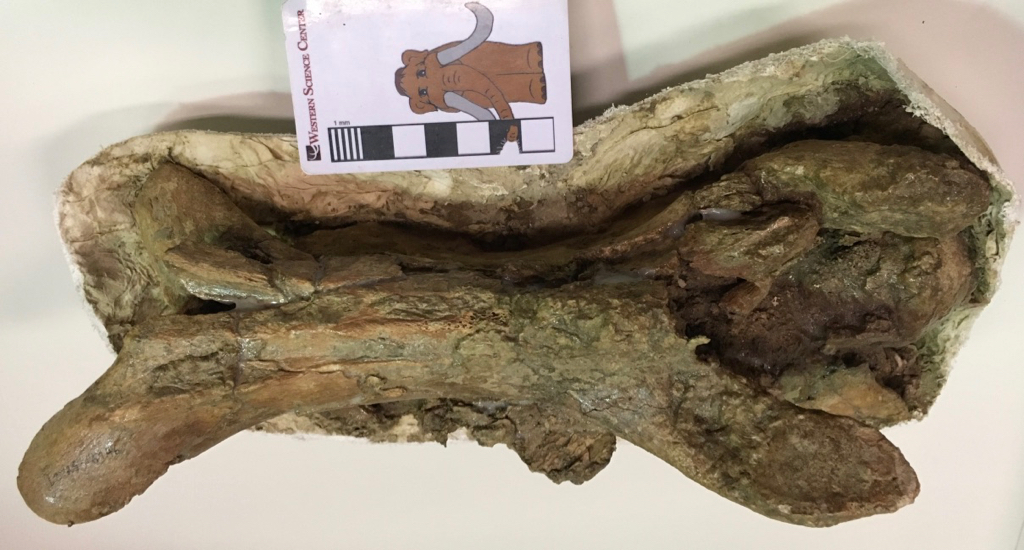 I'm endlessly fascinated by the strange skeleton of the western camel, Camelops hesternus. Camelops was a massive animal, and many of its bones were so large they can easily be mistaken for those from a bison. Yet other parts of the skeleton are almost delicate.The long, slender bone shown above is a Camelops neck vertebra. Camelops had a long neck, but like almost all other mammals the neck had only seven vertebrae, so each vertebra had to be pretty elongate. (Most non-mammals with long necks have lots of shorter vertebrae, although there were exceptions.) The vertebra is shown in dorsal view (from above), and the front is to the right. The yoke-shaped structures at each end at the prezygopophyses (at the front) and the postzygopophyses (at the back), which articulated respectively with the zygopophyses of the preceding and following vertebrae.
I'm endlessly fascinated by the strange skeleton of the western camel, Camelops hesternus. Camelops was a massive animal, and many of its bones were so large they can easily be mistaken for those from a bison. Yet other parts of the skeleton are almost delicate.The long, slender bone shown above is a Camelops neck vertebra. Camelops had a long neck, but like almost all other mammals the neck had only seven vertebrae, so each vertebra had to be pretty elongate. (Most non-mammals with long necks have lots of shorter vertebrae, although there were exceptions.) The vertebra is shown in dorsal view (from above), and the front is to the right. The yoke-shaped structures at each end at the prezygopophyses (at the front) and the postzygopophyses (at the back), which articulated respectively with the zygopophyses of the preceding and following vertebrae.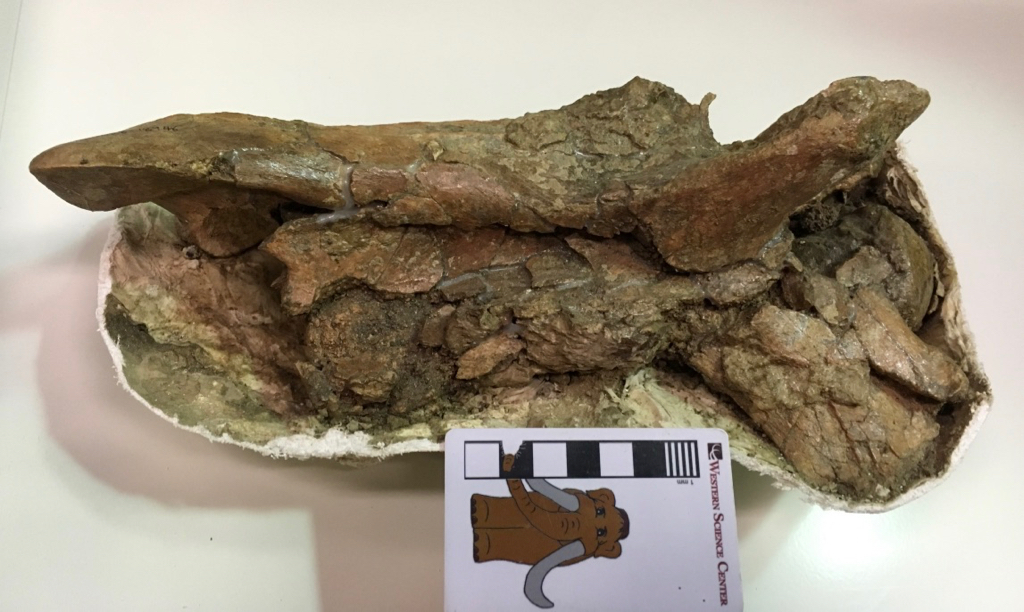 Looking at the right side, the ball joint at the front of the vertebral centrum is visible on the right. This corresponded to a socket on the back of the preceding vertebra, but didn't actually fit tightly into the socket as a large cartilage pad separated them in life. The large bony projection on the lower right is the right anteroventral costellar process. These processes provided attachment areas from some of the neck muscles, and are uniquely large in the camels.This particular vertebra was collected in 1999 near the East Dam of Diamond Valley Lake, and is probably around 50,000 years old.
Looking at the right side, the ball joint at the front of the vertebral centrum is visible on the right. This corresponded to a socket on the back of the preceding vertebra, but didn't actually fit tightly into the socket as a large cartilage pad separated them in life. The large bony projection on the lower right is the right anteroventral costellar process. These processes provided attachment areas from some of the neck muscles, and are uniquely large in the camels.This particular vertebra was collected in 1999 near the East Dam of Diamond Valley Lake, and is probably around 50,000 years old. This may look a bit like a zombie hand reaching from the grave in some B-horror movie (at least it does to me). In fact, it's a fossil that's quite a bit more interesting and less dangerous than a zombie hand.This is part of the lower jaw of the western camel Camelops hesternus, a fairly common species across western North America in the Late Pleistocene. This is the chin, technically called the mandibular symphysis, seen from underneath (ventral view). The forked structure on the left is behind the symphysis, where the left and right dentary bones separate to form each side of the lower jaw. The "fingers" on the right are the incisor teeth.Here's the dorsal view:
This may look a bit like a zombie hand reaching from the grave in some B-horror movie (at least it does to me). In fact, it's a fossil that's quite a bit more interesting and less dangerous than a zombie hand.This is part of the lower jaw of the western camel Camelops hesternus, a fairly common species across western North America in the Late Pleistocene. This is the chin, technically called the mandibular symphysis, seen from underneath (ventral view). The forked structure on the left is behind the symphysis, where the left and right dentary bones separate to form each side of the lower jaw. The "fingers" on the right are the incisor teeth.Here's the dorsal view: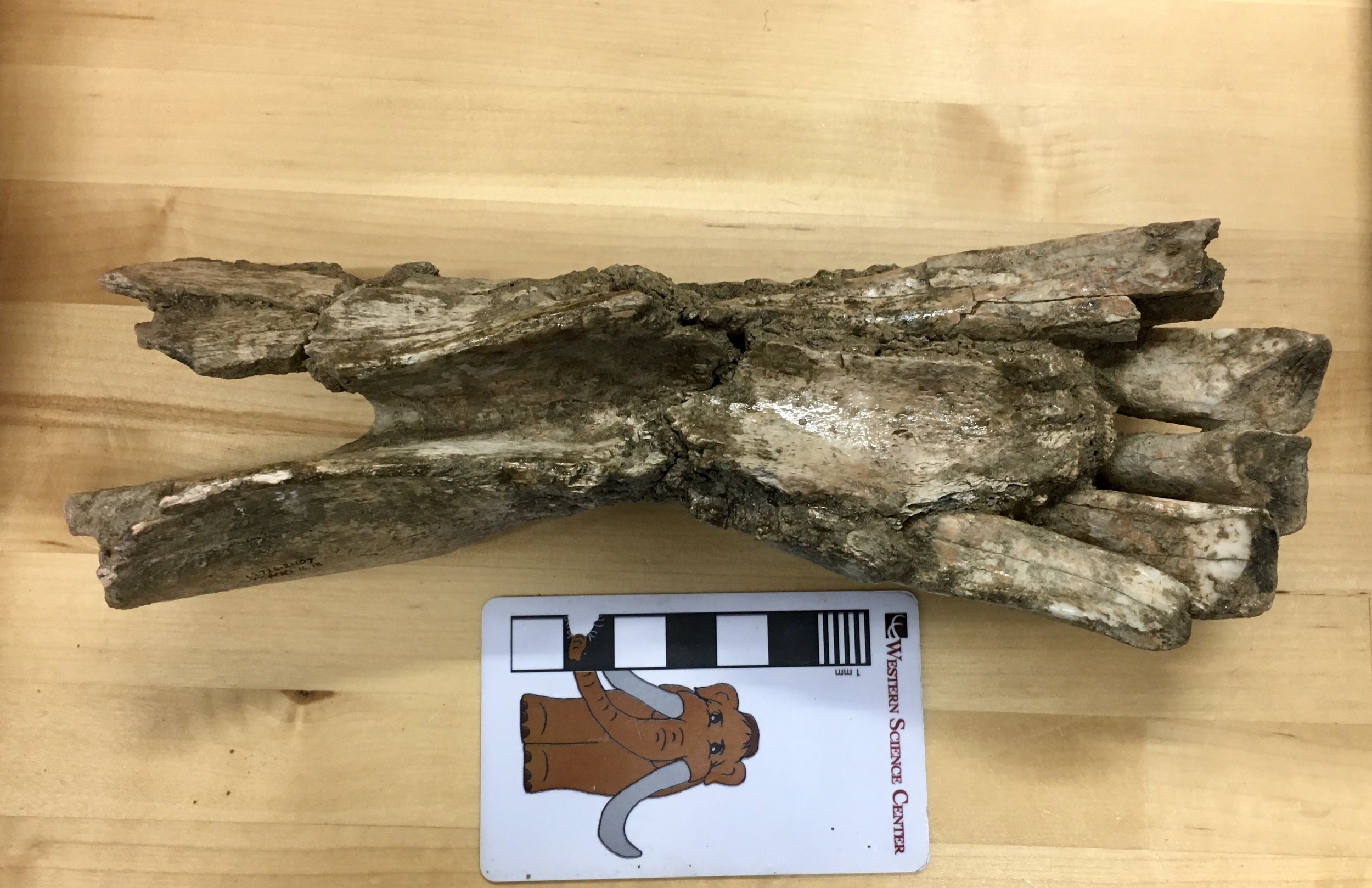 The incisors are more clearly visible in this view. Camels have three lower incisors on each side of the lower jaw; this specimen preserves all three on the right side, but only the first two on the left.Below is a lateral view of the right side:
The incisors are more clearly visible in this view. Camels have three lower incisors on each side of the lower jaw; this specimen preserves all three on the right side, but only the first two on the left.Below is a lateral view of the right side: Because the bone is damaged on this side the entire length of the 3rd incisor is visible (minus whatever part of the tooth wore away before the camel died). Camels eat a tough, abrasive diet that is hard on teeth; camels compensate for this in part by having really long incisors that take a long time to wear down (the technical term - because OF COURSE there's a technical term! - is hypsodonty).We have more of this jaw, and it appears that there are no lower canine teeth. Since this is an adult animal, I suspect that it represents a female, since male camels (including Camelops) tend to have fairly prominent upper and lower canines. However, I need to do a little more research on Camelops to confirm that it displays this type of sexual dimorphism.Here's a close-up of the occlusal surfaces of the teeth:
Because the bone is damaged on this side the entire length of the 3rd incisor is visible (minus whatever part of the tooth wore away before the camel died). Camels eat a tough, abrasive diet that is hard on teeth; camels compensate for this in part by having really long incisors that take a long time to wear down (the technical term - because OF COURSE there's a technical term! - is hypsodonty).We have more of this jaw, and it appears that there are no lower canine teeth. Since this is an adult animal, I suspect that it represents a female, since male camels (including Camelops) tend to have fairly prominent upper and lower canines. However, I need to do a little more research on Camelops to confirm that it displays this type of sexual dimorphism.Here's a close-up of the occlusal surfaces of the teeth: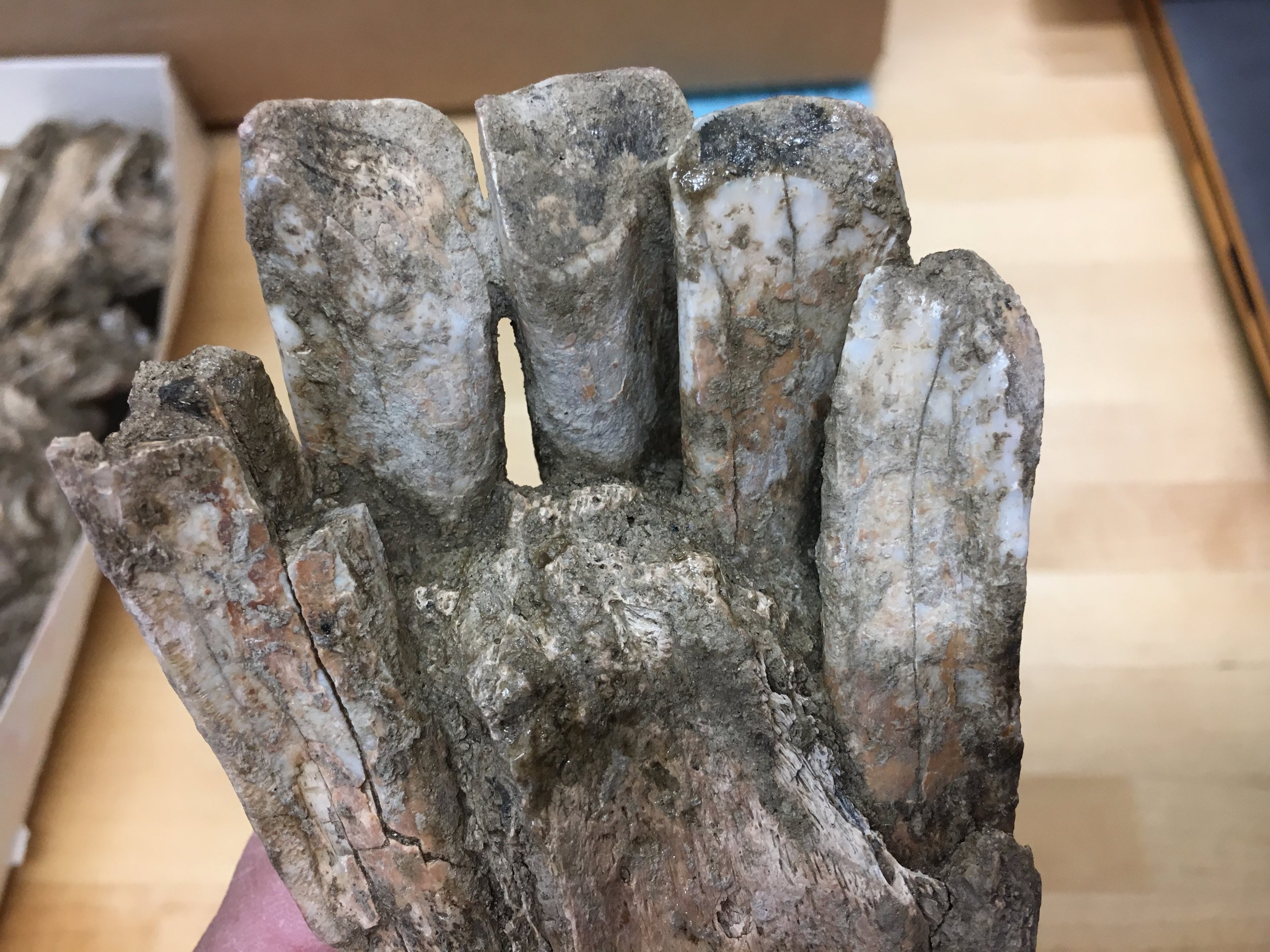 An interesting feature is that each of the three right incisors has a different shape and cross section. Using this specimen as a reference, and assuming there's not a huge amount of individual variation, we should be able to identify the exact position of isolated Camelops incisors from other specimens.We're working on making a 3D photogrammetric model of this specimen, which will be posted on our Sketchfab account in a few weeks.
An interesting feature is that each of the three right incisors has a different shape and cross section. Using this specimen as a reference, and assuming there's not a huge amount of individual variation, we should be able to identify the exact position of isolated Camelops incisors from other specimens.We're working on making a 3D photogrammetric model of this specimen, which will be posted on our Sketchfab account in a few weeks.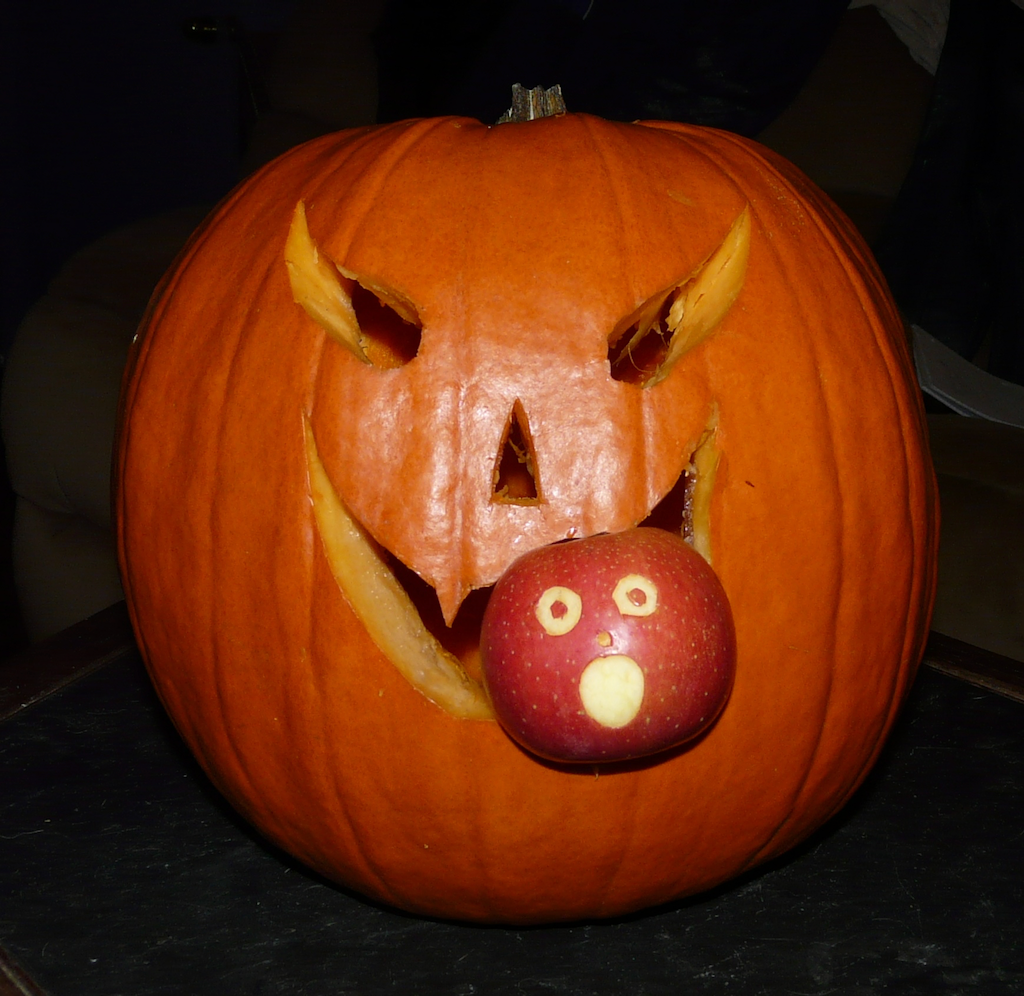 Pumpkins are an interesting fruit. Curcurbita pepo is one of several domesticated species of the genus Curcurbita, vines that are native to the Americas. Curcurbita is a ecologically diverse genus, with some species needing a continuous water supply while others can live in arid conditions, so it is found natively in a variety of habitats. The fruits, which are technically berries, generally have a thick rind with a softer interior where the seeds are located. In most species the rinds are bitter, but the interior is often more palatable and rich in nutrients. As a result it became one of the first domesticated plants in North America more than 8,000 years ago.With large, nutritious fruits, we can be confident that wild Curcurbita were being eaten by more than just humans. In 2006 Lee Newsom and Matthew Mihlbachler published a detailed report about an American mastodon dung deposit in northern Florida. The vast majority of the dung consisted of small cypress twigs, chopped up and stripped of bark, but there were other plant remains from at least 57 species. Among their samples were 156 Curcurbita seeds, showing that this was a popular item on the mastodon menu. Using the Newsom and Mihlbachler paper as a guide, a few years ago we made a simulated piece of mastodon dung for exhibit at WSC, including numerous pumpkin and squash seeds:
Pumpkins are an interesting fruit. Curcurbita pepo is one of several domesticated species of the genus Curcurbita, vines that are native to the Americas. Curcurbita is a ecologically diverse genus, with some species needing a continuous water supply while others can live in arid conditions, so it is found natively in a variety of habitats. The fruits, which are technically berries, generally have a thick rind with a softer interior where the seeds are located. In most species the rinds are bitter, but the interior is often more palatable and rich in nutrients. As a result it became one of the first domesticated plants in North America more than 8,000 years ago.With large, nutritious fruits, we can be confident that wild Curcurbita were being eaten by more than just humans. In 2006 Lee Newsom and Matthew Mihlbachler published a detailed report about an American mastodon dung deposit in northern Florida. The vast majority of the dung consisted of small cypress twigs, chopped up and stripped of bark, but there were other plant remains from at least 57 species. Among their samples were 156 Curcurbita seeds, showing that this was a popular item on the mastodon menu. Using the Newsom and Mihlbachler paper as a guide, a few years ago we made a simulated piece of mastodon dung for exhibit at WSC, including numerous pumpkin and squash seeds: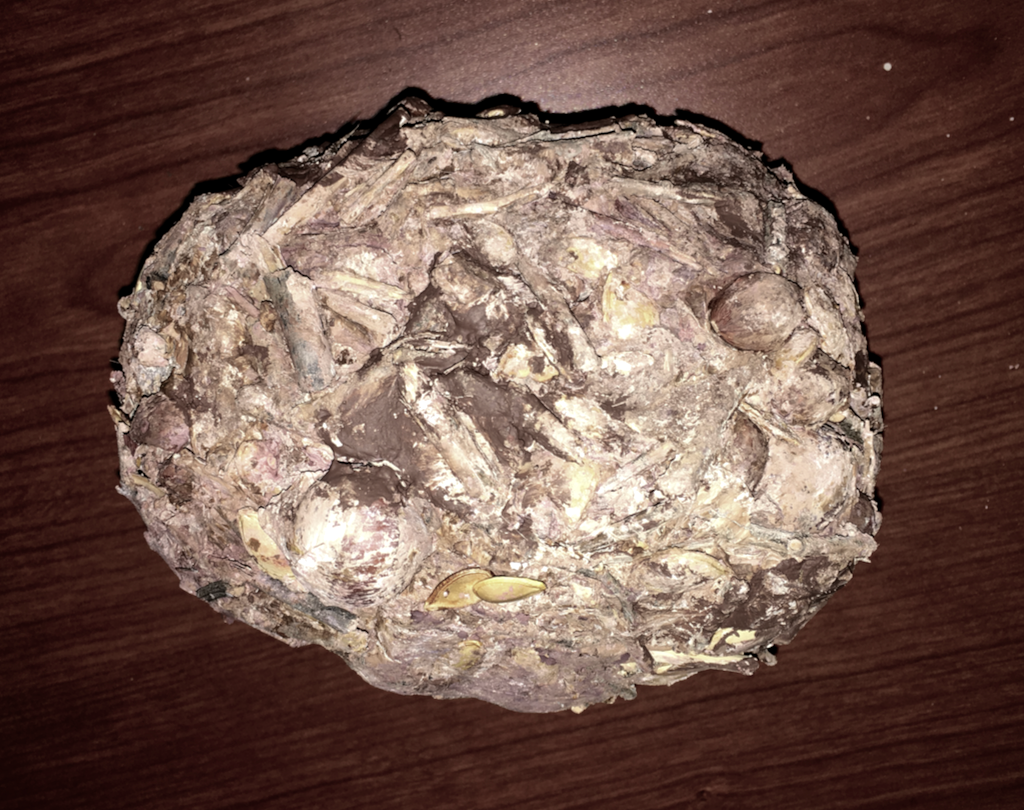 Newsom and Mihlbachler also noted that, while Curcurbita seeds were relatively common in their sample, rind fragments were almost completely absent. It seems that mastodons may have disliked the bitter rinds just like we do, and broken the gourds open to get at the interior. Captive elephants that are fed pumpkins seem to have discovered the same trick:[youtube https://www.youtube.com/watch?v=2CzXH2Eg1hw&w=560&h=315]So far no Pacific mastodon coprolites have been identified, but hopefully one day we'll be able so say as much about their dietary habits.Reference:Lee Newsom and Matthew C. Mihlbachler, 2006. Mastodon (Mammut americanum) diet and foraging patterns based on analysis of dung deposits. Chapter 10 in S. David Webb (ed.), First Floridians and Last Mastodons: The Page-Ladson Site in the Aucilla River, Springer, p. 263-331.
Newsom and Mihlbachler also noted that, while Curcurbita seeds were relatively common in their sample, rind fragments were almost completely absent. It seems that mastodons may have disliked the bitter rinds just like we do, and broken the gourds open to get at the interior. Captive elephants that are fed pumpkins seem to have discovered the same trick:[youtube https://www.youtube.com/watch?v=2CzXH2Eg1hw&w=560&h=315]So far no Pacific mastodon coprolites have been identified, but hopefully one day we'll be able so say as much about their dietary habits.Reference:Lee Newsom and Matthew C. Mihlbachler, 2006. Mastodon (Mammut americanum) diet and foraging patterns based on analysis of dung deposits. Chapter 10 in S. David Webb (ed.), First Floridians and Last Mastodons: The Page-Ladson Site in the Aucilla River, Springer, p. 263-331.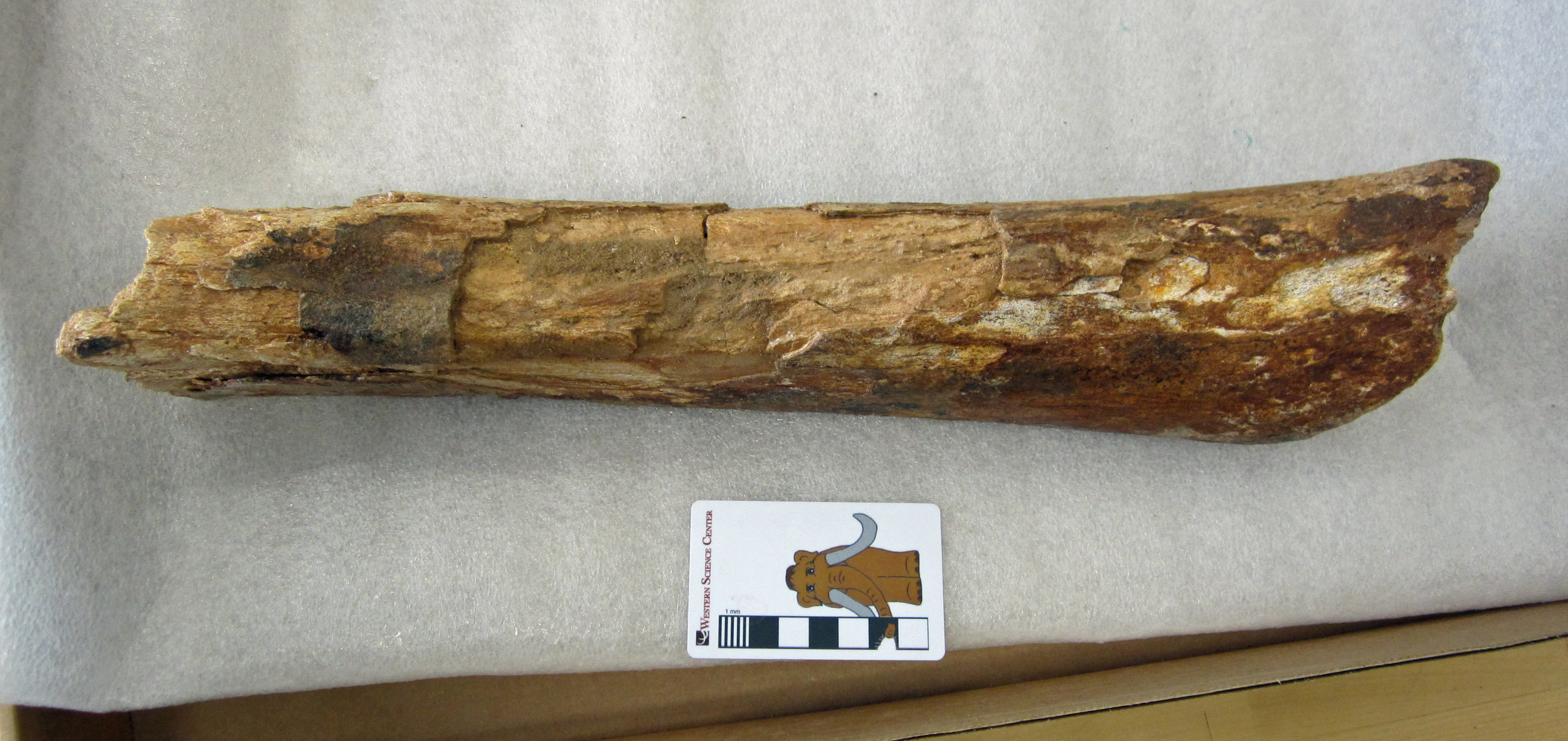 The Diamond Valley collection housed at WSC is an extremely rich record of Ice Age life in southern California, but it is far from the only Pleistocene site represented in the museum's collections.Right now, fossils of mammoths, camels, bison, horses, and other Ice Age megafauna from Joshua Tree National Park are on display in our "Fossils of Joshua Tree" exhibit. We are actively exploring new Pleistocene sites throughout Riverside County with colleagues from several institutions.In April, in conjunction with staff from the U.S. Bureau of Land Management, we collected this large incomplete mammalian limb bone from Pleistocene deposits near Blythe. It has recently been prepared in our lab, so now ahead is the task of comparing it to other large Ice Age mammal fossils and determining what kind of animal it is. It might belong to a large Ice Age camel such as Camelops hesternus, the species also found at Diamond Valley, La Brea Tar Pits, and many other sites in North America. We have much more discover in southern California's Pleistocene.Post by Curator Dr. Andrew McDonald.
The Diamond Valley collection housed at WSC is an extremely rich record of Ice Age life in southern California, but it is far from the only Pleistocene site represented in the museum's collections.Right now, fossils of mammoths, camels, bison, horses, and other Ice Age megafauna from Joshua Tree National Park are on display in our "Fossils of Joshua Tree" exhibit. We are actively exploring new Pleistocene sites throughout Riverside County with colleagues from several institutions.In April, in conjunction with staff from the U.S. Bureau of Land Management, we collected this large incomplete mammalian limb bone from Pleistocene deposits near Blythe. It has recently been prepared in our lab, so now ahead is the task of comparing it to other large Ice Age mammal fossils and determining what kind of animal it is. It might belong to a large Ice Age camel such as Camelops hesternus, the species also found at Diamond Valley, La Brea Tar Pits, and many other sites in North America. We have much more discover in southern California's Pleistocene.Post by Curator Dr. Andrew McDonald.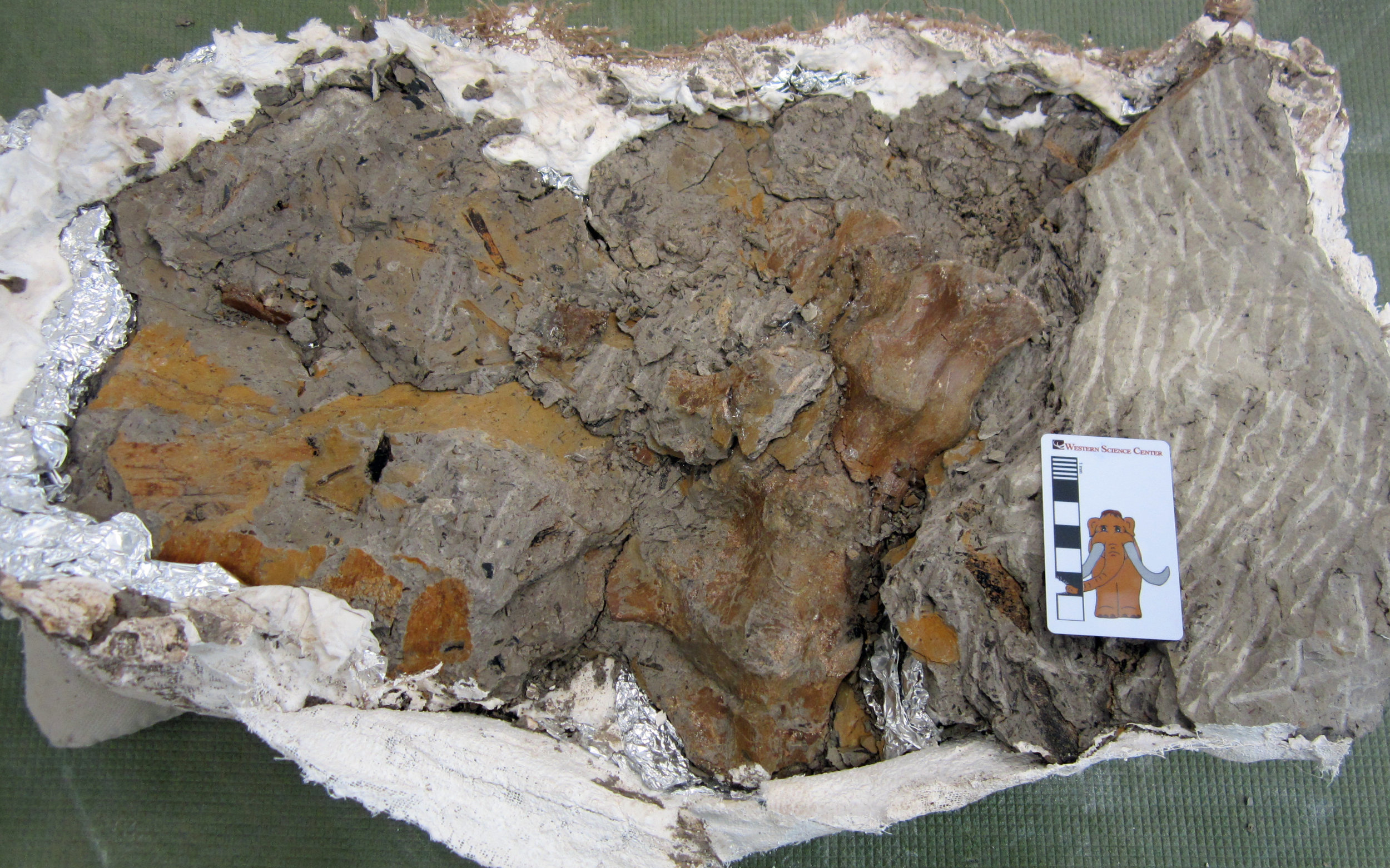 Earlier this week, WSC volunteer Joe Reavis began preparing another of these jackets, which contains the rest of the sacrum, the series of fused vertebrae nestled between the right and left hip bones of the ceratopsid. In the image, just to the left of the Max scale bar, you can see a sequence of four fused vertebrae. Ceratopsids have around 10 sacral vertebrae, so these four coupled with the five from the other jacket that I posted about in May mean that we probably have almost the entire sacrum. Opening each new jacket reveals more about this relative of Triceratops that lived 79 million years ago.
Earlier this week, WSC volunteer Joe Reavis began preparing another of these jackets, which contains the rest of the sacrum, the series of fused vertebrae nestled between the right and left hip bones of the ceratopsid. In the image, just to the left of the Max scale bar, you can see a sequence of four fused vertebrae. Ceratopsids have around 10 sacral vertebrae, so these four coupled with the five from the other jacket that I posted about in May mean that we probably have almost the entire sacrum. Opening each new jacket reveals more about this relative of Triceratops that lived 79 million years ago. Among the most abundant and aesthetically varied fossils are the ammonites. These shelled marine mollusks are related to living cephalopods such as octopus, squid, and cuttlefish. With a fossil record that spans the globe and the Devonian through Cretaceous periods (408 - 66 million years ago), ammonites were very successful animals, evolving into a range of sizes, habitats, and shell morphologies. Their long evolutionary history ended 66 million years ago, in the same mass extinction that eliminated non-avian dinosaurs and many other animals and plants.Ammonites are very useful for determining the age of the rocks in which they occur, with different shell morphologies occurring only in certain slices of time. For example, in previous posts, I have discussed Cretaceous dinosaurs from New Mexico. Although we don't yet know the exact age of the Menefee Formation, the rock layer in which the dinosaur fossils occur, we do know that they must be older than 78.5 million years because the rocks right above the Menefee contain an ammonite called Baculites perplexus, which is tied to an age of about 78.5 million years old.In today's photo are four fossil ammonite shells, each representing a different species. These shells were donated to the Western Science Center and come from Tarrant County, Texas. Dating to around 105 million years ago, these ammonites lived in the early history of a shallow saltwater sea that covered much of the interior of North America during the Late Cretaceous. You can see these four ammonites and the fossils of many other prehistoric sea creatures in the Western Science Center's new temporary exhibit, "Life in the Ancient Seas".
Among the most abundant and aesthetically varied fossils are the ammonites. These shelled marine mollusks are related to living cephalopods such as octopus, squid, and cuttlefish. With a fossil record that spans the globe and the Devonian through Cretaceous periods (408 - 66 million years ago), ammonites were very successful animals, evolving into a range of sizes, habitats, and shell morphologies. Their long evolutionary history ended 66 million years ago, in the same mass extinction that eliminated non-avian dinosaurs and many other animals and plants.Ammonites are very useful for determining the age of the rocks in which they occur, with different shell morphologies occurring only in certain slices of time. For example, in previous posts, I have discussed Cretaceous dinosaurs from New Mexico. Although we don't yet know the exact age of the Menefee Formation, the rock layer in which the dinosaur fossils occur, we do know that they must be older than 78.5 million years because the rocks right above the Menefee contain an ammonite called Baculites perplexus, which is tied to an age of about 78.5 million years old.In today's photo are four fossil ammonite shells, each representing a different species. These shells were donated to the Western Science Center and come from Tarrant County, Texas. Dating to around 105 million years ago, these ammonites lived in the early history of a shallow saltwater sea that covered much of the interior of North America during the Late Cretaceous. You can see these four ammonites and the fossils of many other prehistoric sea creatures in the Western Science Center's new temporary exhibit, "Life in the Ancient Seas".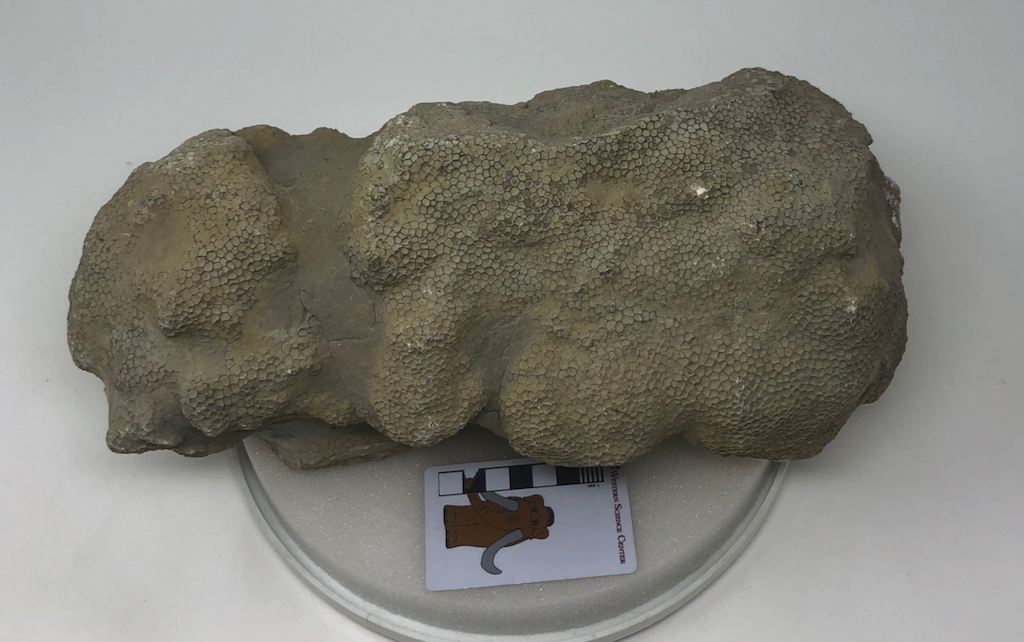 Corals are such an iconic part of the modern ocean, it's easy to overlook the fact that they didn't become widespread until the Ordovician Period, 4 billion years after the Earth formed and some 30 million years after the Cambrian Explosion.The coral shown above is Foerstephyllum, and example of a tabulate coral. The Tabulata are one of the two common types of fossil corals in the Paleozoic Era, along with the Rugosa. Of course, an important reason these groups are common as fossils is because they made large calcite structures that preserve very well. At least in the modern ocean, there are many soft-bodied corals that would be much less likely to fossilize, and that may have been the case in the past as well.This Foerstephyllum head comes from the Drakes Formation near Bardstown, Kentucky. There is a layer within this unit that is made mostly of large coral heads:
Corals are such an iconic part of the modern ocean, it's easy to overlook the fact that they didn't become widespread until the Ordovician Period, 4 billion years after the Earth formed and some 30 million years after the Cambrian Explosion.The coral shown above is Foerstephyllum, and example of a tabulate coral. The Tabulata are one of the two common types of fossil corals in the Paleozoic Era, along with the Rugosa. Of course, an important reason these groups are common as fossils is because they made large calcite structures that preserve very well. At least in the modern ocean, there are many soft-bodied corals that would be much less likely to fossilize, and that may have been the case in the past as well.This Foerstephyllum head comes from the Drakes Formation near Bardstown, Kentucky. There is a layer within this unit that is made mostly of large coral heads: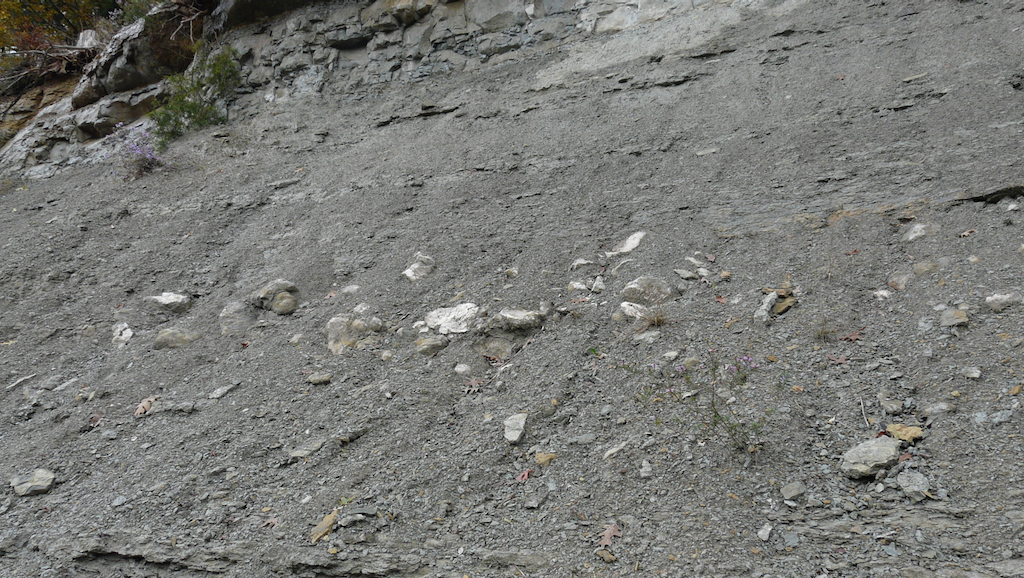 This bed is close to the top of the Ordovician; in fact, the massive rocks visible in the upper left corner are Silurian, although I think there is an unconformity between them.Tabulate corals remained as significant reef-builders up to the end of the Paleozoic Era. They went extinct, along with the rugose corals and about 90% or more of all marine species, in the devastating mass extinction at the end of the Permian Period.This specimen of Foerstephyllum is currently on display at the Western Science Center in the "Life in the Ancient Seas" exhibit, and a 3D model is available for viewing and download on SketchFab at
This bed is close to the top of the Ordovician; in fact, the massive rocks visible in the upper left corner are Silurian, although I think there is an unconformity between them.Tabulate corals remained as significant reef-builders up to the end of the Paleozoic Era. They went extinct, along with the rugose corals and about 90% or more of all marine species, in the devastating mass extinction at the end of the Permian Period.This specimen of Foerstephyllum is currently on display at the Western Science Center in the "Life in the Ancient Seas" exhibit, and a 3D model is available for viewing and download on SketchFab at 








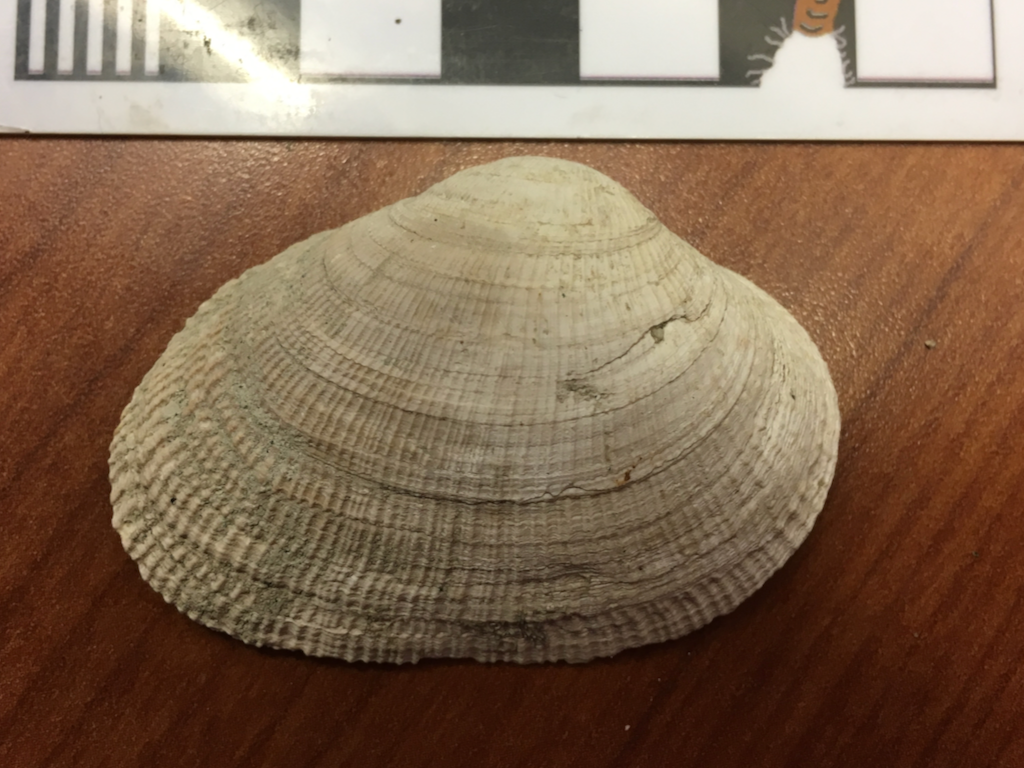 At the end of this month WSC is opening a new exhibit, "Life in the Ancient Seas". A big portion of the staff's efforts are currently focused on getting this ready, including writing labels for individual specimens; this may be the largest exhibit we've ever done in terms of shear specimen count! But sometimes these labels can be difficult to write, as the information is often obscure.This shell comes from Pliocene deposits near Chuckatuck, Virginia, specifically the Moore House Member of the Yorktown Formation. We have a small collection from this site at WSC, numbering perhaps 200-300 shells. Ten of them are from this species. This is a site I'm quite familiar with; I collected there numerous times when I worked at the Virginia Museum of Natural History, and in fact Brett collected this specimen on a field trip I ran there about 10 years ago. My first job at VMNH was sorting fossil mollusks from this and other localities, so while I'm not an expert on Pliocene mollusks I'm probably more familiar with them than is typical for a vertebrate paleontologist.This shell had me stumped, though. At first I thought it was from the genus Striarca, like the example below from the
At the end of this month WSC is opening a new exhibit, "Life in the Ancient Seas". A big portion of the staff's efforts are currently focused on getting this ready, including writing labels for individual specimens; this may be the largest exhibit we've ever done in terms of shear specimen count! But sometimes these labels can be difficult to write, as the information is often obscure.This shell comes from Pliocene deposits near Chuckatuck, Virginia, specifically the Moore House Member of the Yorktown Formation. We have a small collection from this site at WSC, numbering perhaps 200-300 shells. Ten of them are from this species. This is a site I'm quite familiar with; I collected there numerous times when I worked at the Virginia Museum of Natural History, and in fact Brett collected this specimen on a field trip I ran there about 10 years ago. My first job at VMNH was sorting fossil mollusks from this and other localities, so while I'm not an expert on Pliocene mollusks I'm probably more familiar with them than is typical for a vertebrate paleontologist.This shell had me stumped, though. At first I thought it was from the genus Striarca, like the example below from the 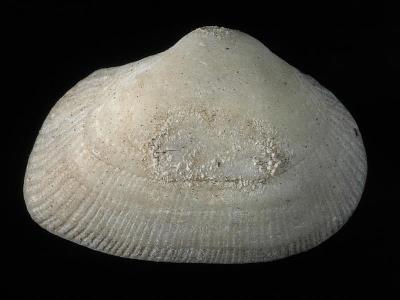 But a quick look at the other side of the shell ruled this out. Striarca is a member of the order Arcoidea, which have very distinctive hinges. But the Chuckatuck shell had a different hinge, that looked to me like a member of the Veneroida. Below, the first image is Striarca (from
But a quick look at the other side of the shell ruled this out. Striarca is a member of the order Arcoidea, which have very distinctive hinges. But the Chuckatuck shell had a different hinge, that looked to me like a member of the Veneroida. Below, the first image is Striarca (from 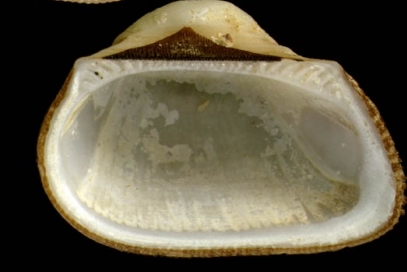
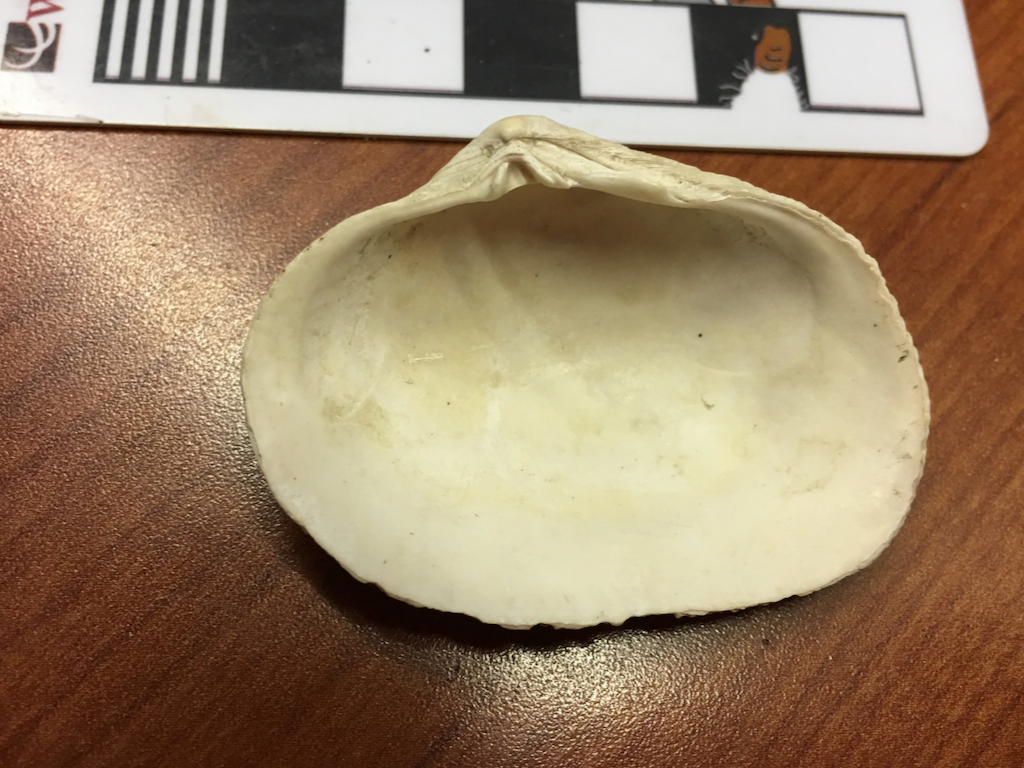 The problem was that none of the references I had at hand seemed to include a veneroid that matched both the size and appearance of this shell. Image searches online were not producing much of use, so I went to Twitter. Within a day or so I got a response:
The problem was that none of the references I had at hand seemed to include a veneroid that matched both the size and appearance of this shell. Image searches online were not producing much of use, so I went to Twitter. Within a day or so I got a response: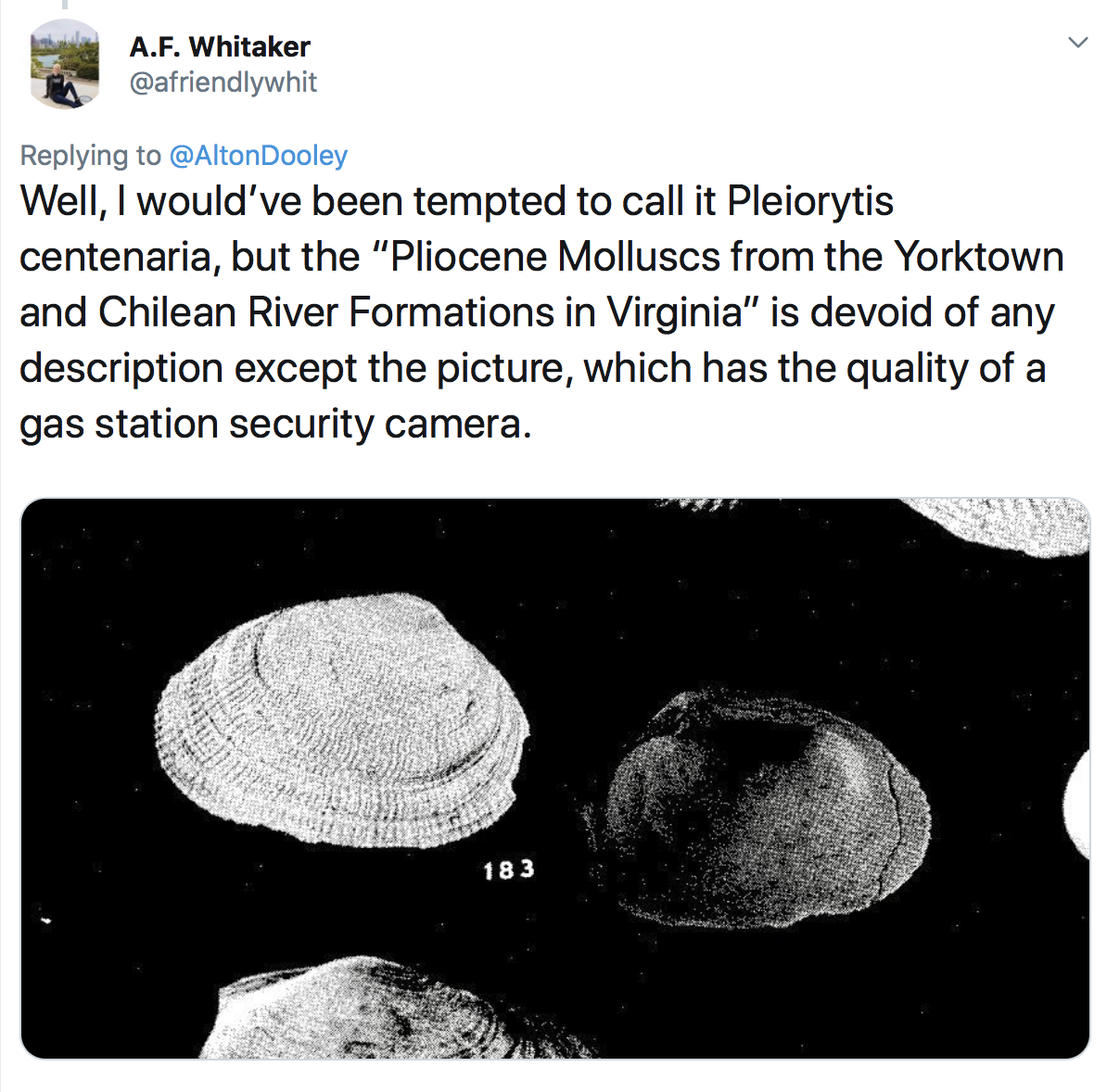 Unfortunately searches for Pleiorytis centenaria didn't turn up much. But then I received another Twitter response:
Unfortunately searches for Pleiorytis centenaria didn't turn up much. But then I received another Twitter response: So that solved it! Asaphis is a veneroid, a member of a family known as the sunset clams. There's even a
So that solved it! Asaphis is a veneroid, a member of a family known as the sunset clams. There's even a 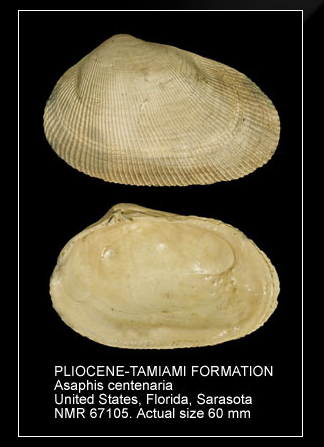 So, mystery solved! And this allows us to display the particular specimen that I wanted to include in the exhibit:
So, mystery solved! And this allows us to display the particular specimen that I wanted to include in the exhibit: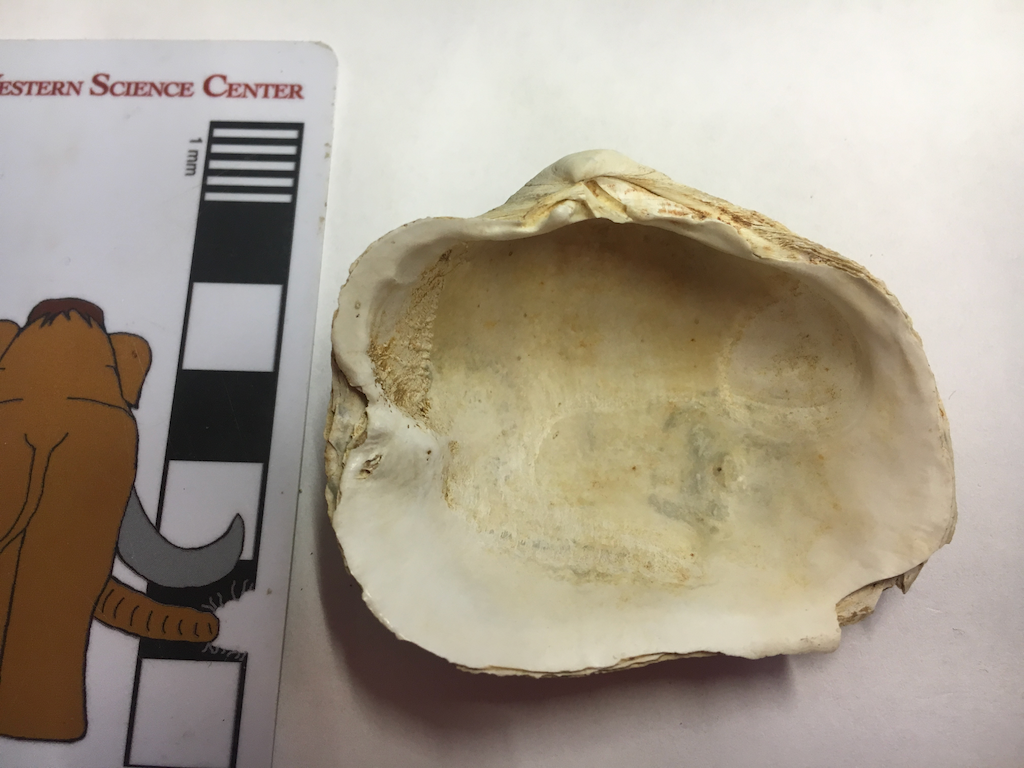 Notice the odd wrinkle on the left side of the shell. While Asaphis and other clams are sometimes misshapen because of where they happen to be growing, I don't think that's what happened here, because I've seen similar wrinkles in shells from mobile taxa, such as scallops. This looks like the clam suffered a non-fatal injury at some point. Perhaps a crab or some other predator tried to crack open the shell. The attack was unsuccessful, but it did some damage and the crab repaired the damage by depositing new shell layers over the injury as it grew. I love features like this, traces that give us glimpses into the daily lives of organisms that happened millions of years in the past.Thanks to @afriendlywhit and @paleomollusk for their help with this identification. "Life in the Ancient Seas" opens to the public on August 31.
Notice the odd wrinkle on the left side of the shell. While Asaphis and other clams are sometimes misshapen because of where they happen to be growing, I don't think that's what happened here, because I've seen similar wrinkles in shells from mobile taxa, such as scallops. This looks like the clam suffered a non-fatal injury at some point. Perhaps a crab or some other predator tried to crack open the shell. The attack was unsuccessful, but it did some damage and the crab repaired the damage by depositing new shell layers over the injury as it grew. I love features like this, traces that give us glimpses into the daily lives of organisms that happened millions of years in the past.Thanks to @afriendlywhit and @paleomollusk for their help with this identification. "Life in the Ancient Seas" opens to the public on August 31. 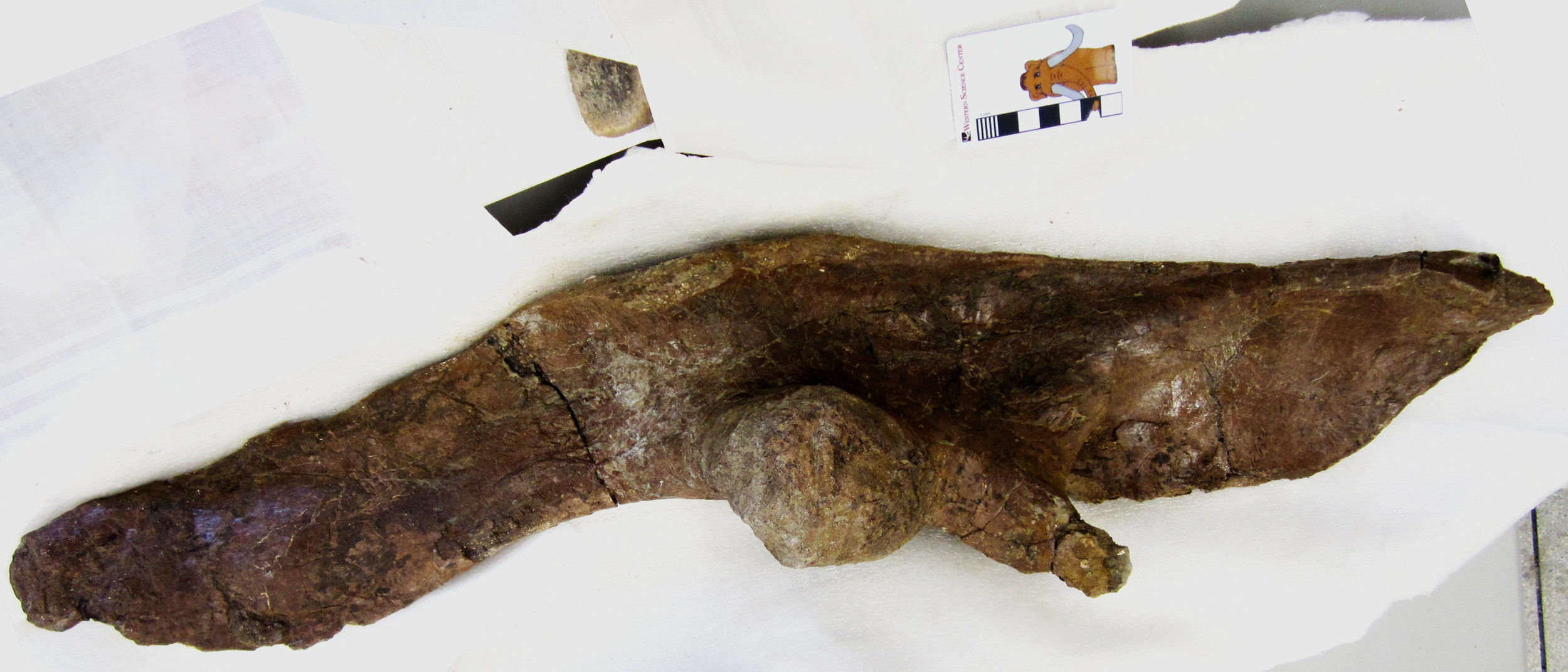
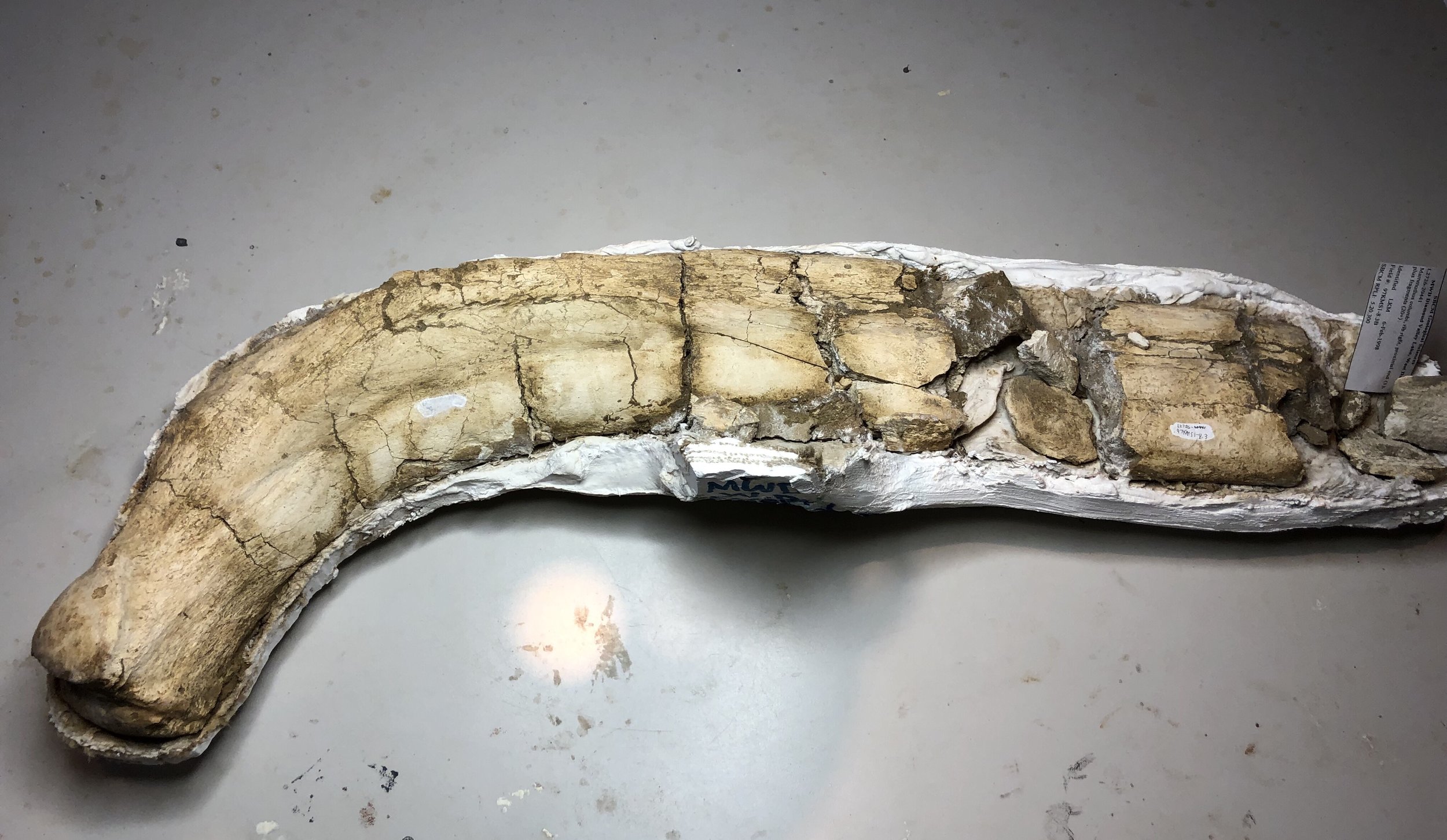 Organisms don't exist in a vacuum. The whole concept of an ecosystem emphasizes the interactions between an organism and its environment, including with other organisms. A large organism like a mammoth can have wide-ranging effects on numerous other organisms, even after its death.The specimen shown above is a partial Colombian mammoth rib from Diamond Valley Lake, currently being prepared by volunteer Tim Dooley. We have a large number of rib fragments such as this one, and at first glance they all look pretty much the same. But under close examination they often tell unique stories.After removing glue used to stabilize the specimen in the field, we realized this bone has a number of small, circular pits covering its surface:
Organisms don't exist in a vacuum. The whole concept of an ecosystem emphasizes the interactions between an organism and its environment, including with other organisms. A large organism like a mammoth can have wide-ranging effects on numerous other organisms, even after its death.The specimen shown above is a partial Colombian mammoth rib from Diamond Valley Lake, currently being prepared by volunteer Tim Dooley. We have a large number of rib fragments such as this one, and at first glance they all look pretty much the same. But under close examination they often tell unique stories.After removing glue used to stabilize the specimen in the field, we realized this bone has a number of small, circular pits covering its surface:
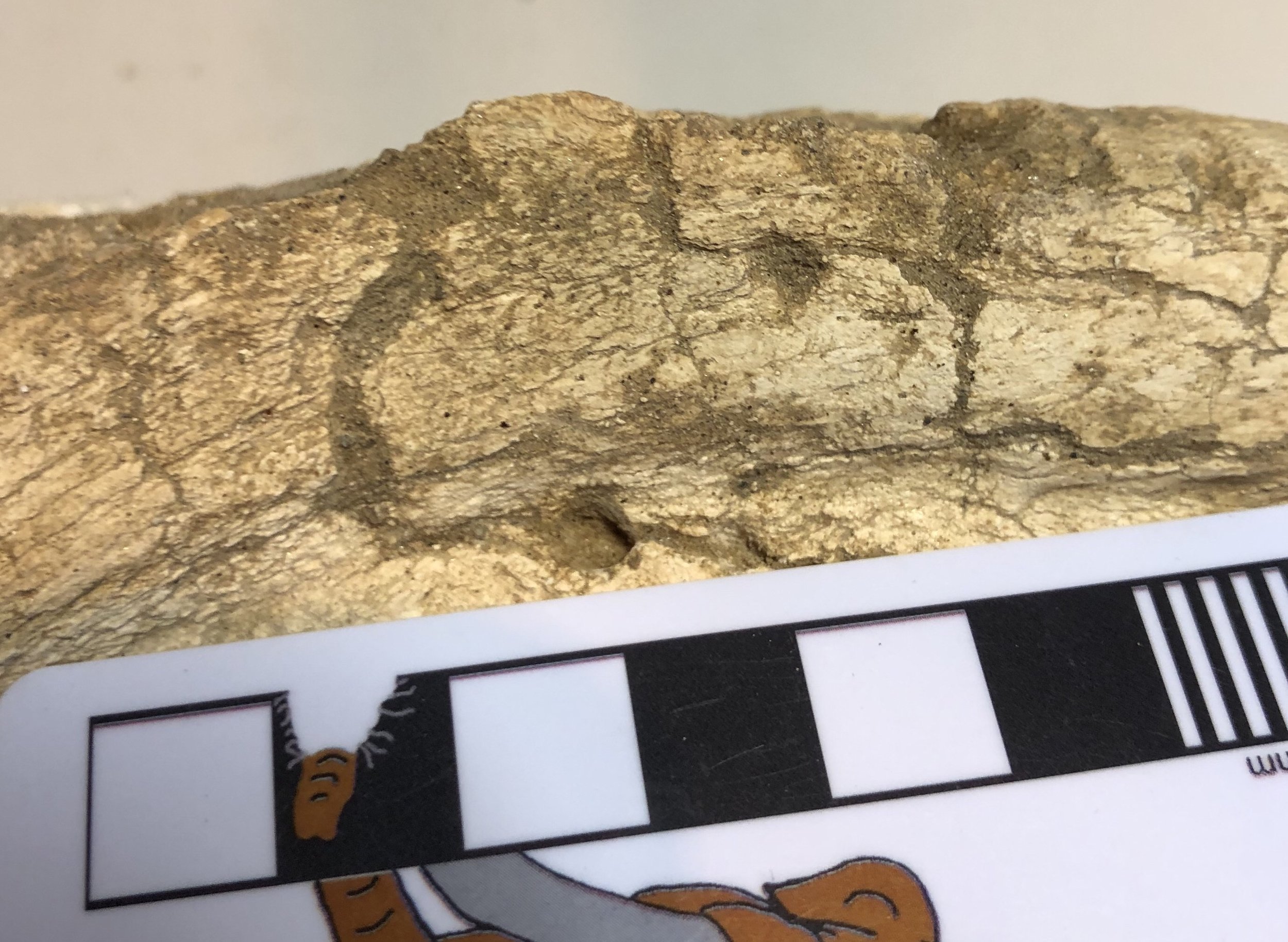
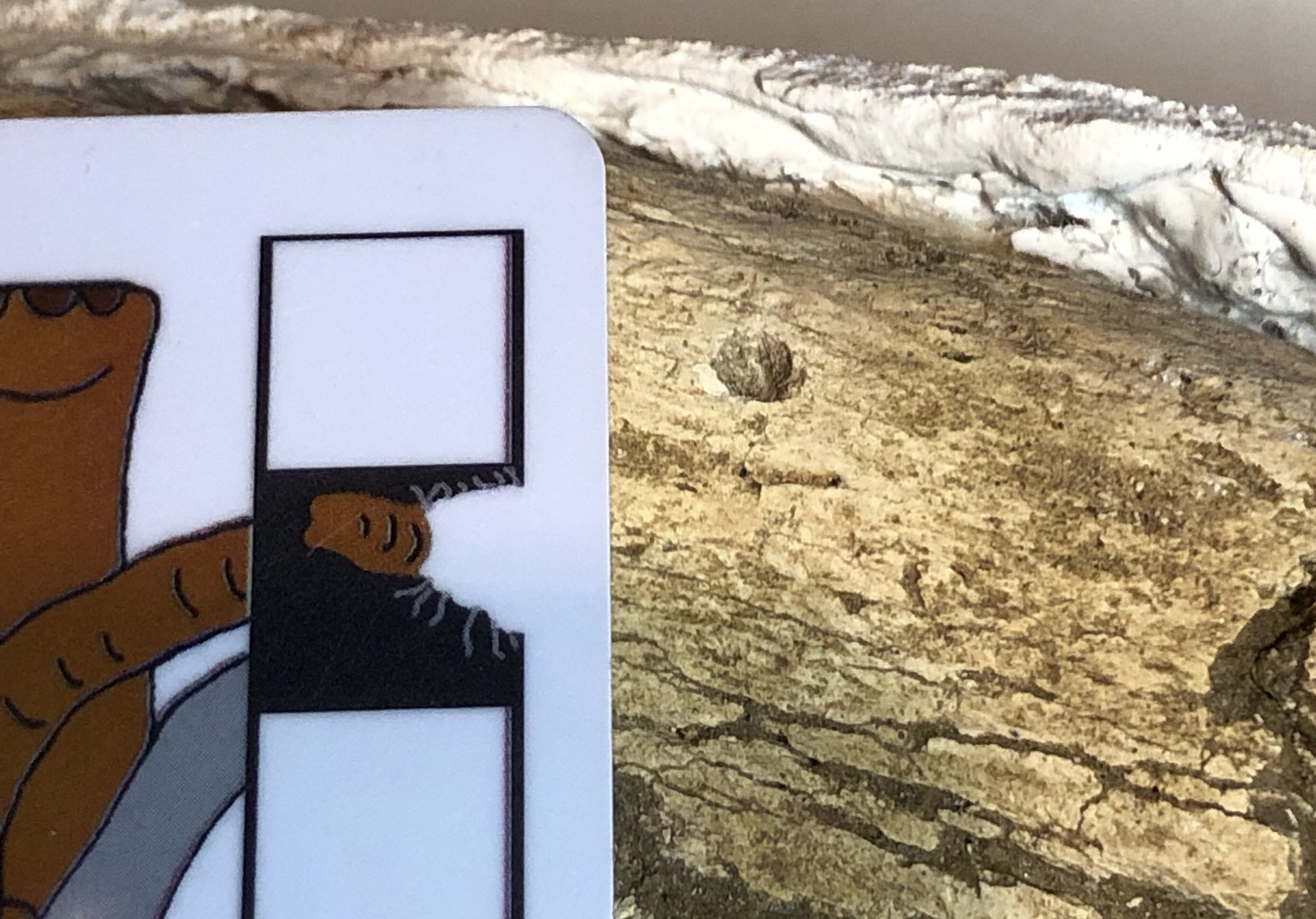 There are also some rough, pitted areas:
There are also some rough, pitted areas: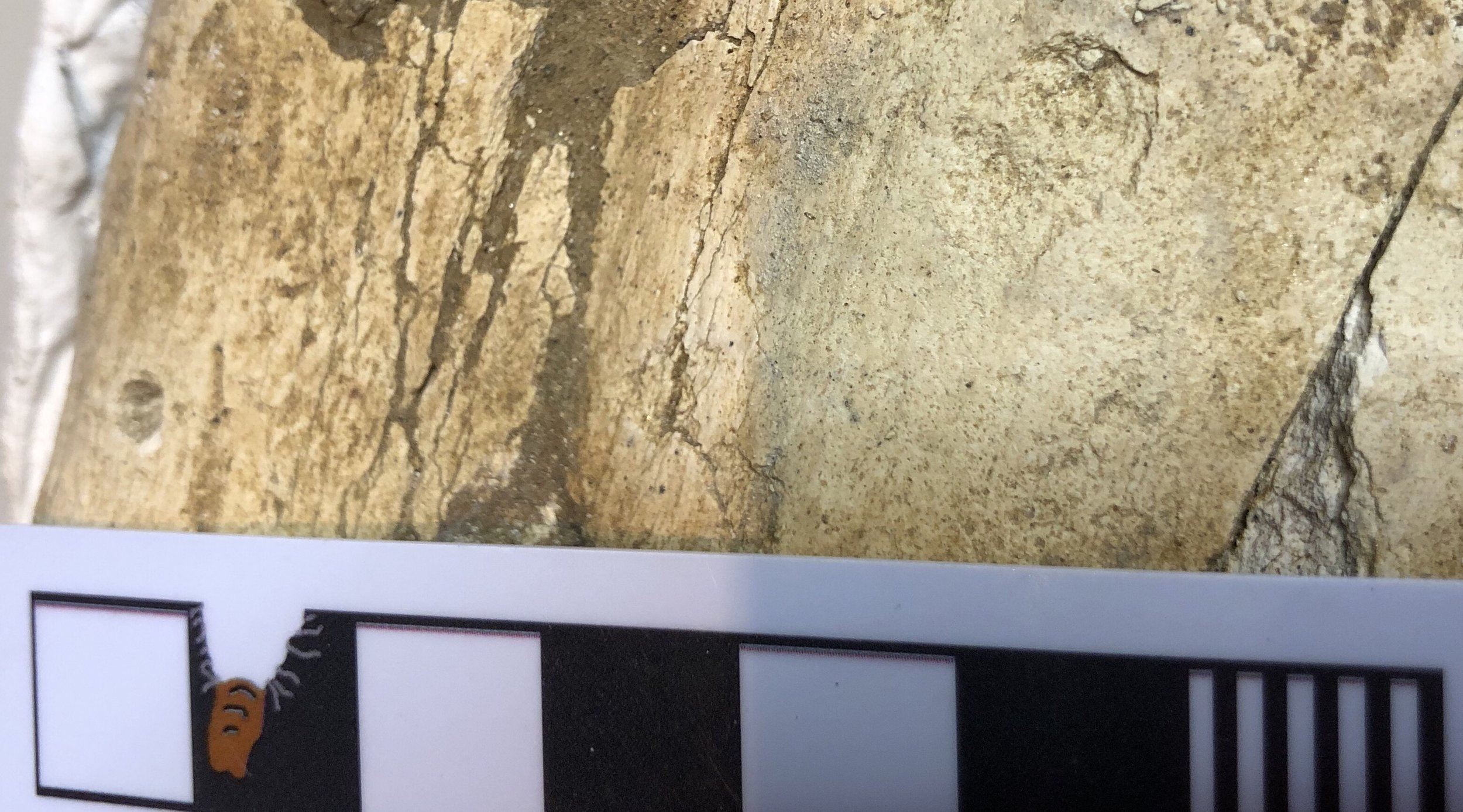 While I'm not 100% sure, I believe these are traces made by scavenging insects or other invertebrates, especially the rough patches in the last photo. I'm a little less certain of the circular holes. They are reminiscent of vertebrate bite marks, but they aren't paired and are tiny (all are less than 5 mm in diameter), so I think some sort of burrowing or bone-eating invertebrate is more likely.Marks such as these are quite common on DVL bones, and may eventually give us some insight into the invertebrate fauna from the valley, which left us almost no body fossils.
While I'm not 100% sure, I believe these are traces made by scavenging insects or other invertebrates, especially the rough patches in the last photo. I'm a little less certain of the circular holes. They are reminiscent of vertebrate bite marks, but they aren't paired and are tiny (all are less than 5 mm in diameter), so I think some sort of burrowing or bone-eating invertebrate is more likely.Marks such as these are quite common on DVL bones, and may eventually give us some insight into the invertebrate fauna from the valley, which left us almost no body fossils.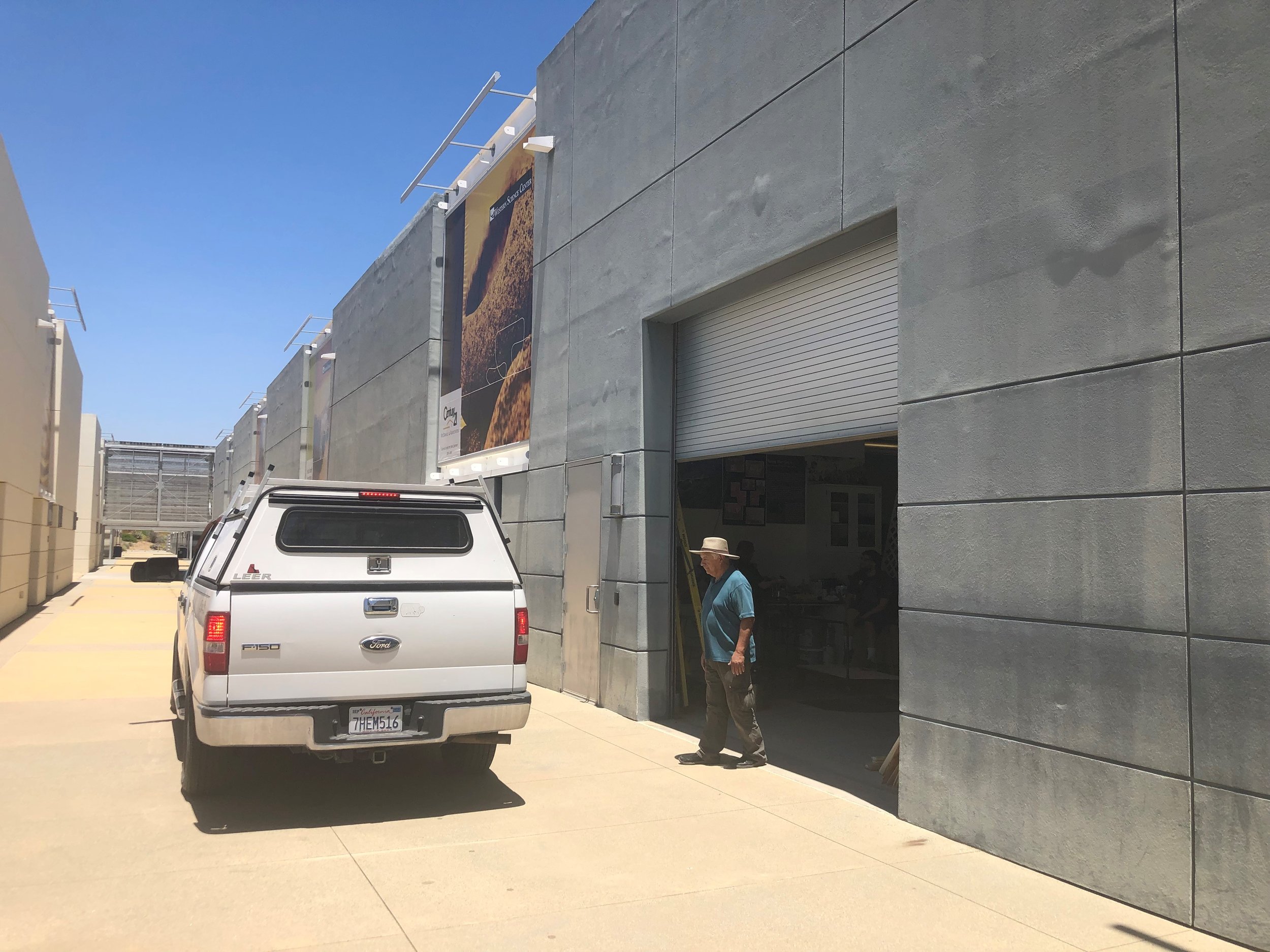 The first part of the Western Science Center's summer field season with Zuni Dinosaur Institute for the Geosciences and the Southwest Paleontological Society is now over, and that means lots of new fossils have been brought to the museum!
The first part of the Western Science Center's summer field season with Zuni Dinosaur Institute for the Geosciences and the Southwest Paleontological Society is now over, and that means lots of new fossils have been brought to the museum!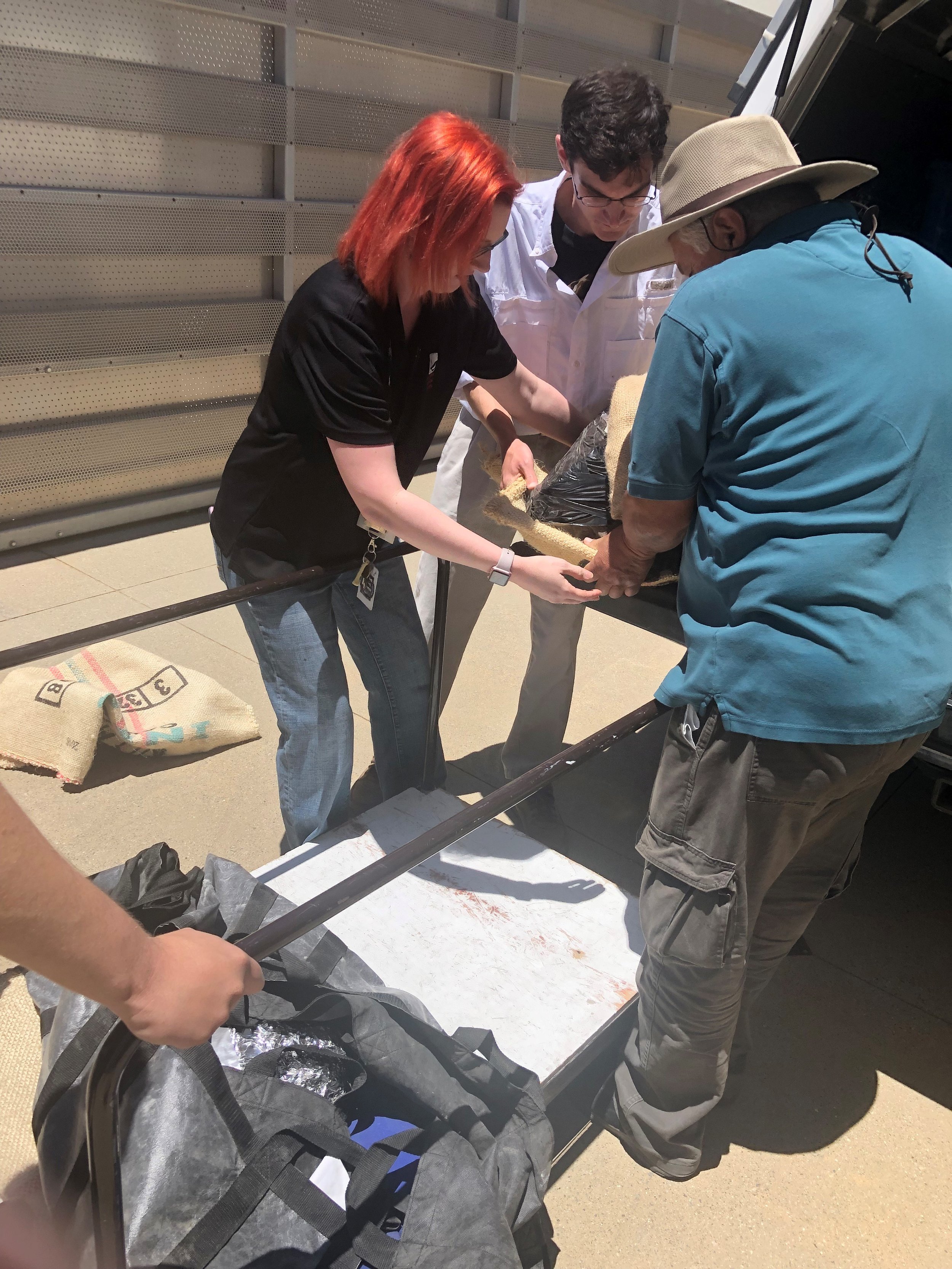 WSC staff and volunteers have spent the last two weeks out in New Mexico's Menefee Formation, where new species like Invictarx zephyri and the theropod Dynamoterror dynastes were discovered. A literal ton of fossil jackets have been unloaded into the museum, and we'll now spend the foreseeable future getting our new specimens ready for research, outreach, and exhibition.
WSC staff and volunteers have spent the last two weeks out in New Mexico's Menefee Formation, where new species like Invictarx zephyri and the theropod Dynamoterror dynastes were discovered. A literal ton of fossil jackets have been unloaded into the museum, and we'll now spend the foreseeable future getting our new specimens ready for research, outreach, and exhibition.![fieldwork4]](http://static1.squarespace.com/static/5c7dbcb0e666693012e253e8/5e06577dccb29d33b46f6433/5e0657d2ccb29d33b46f86bf/1577474002689/fieldwork4.jpg?format=original) So what have we found? That's still being determined - though we know much of the material includes more dinosaurs. The Menefee Formation is part of the Late Cretaceous and is approximately 80 million years old. This span of time is not particularly well understood, and we hope that our work in the area will continue to shed light on this period!
So what have we found? That's still being determined - though we know much of the material includes more dinosaurs. The Menefee Formation is part of the Late Cretaceous and is approximately 80 million years old. This span of time is not particularly well understood, and we hope that our work in the area will continue to shed light on this period!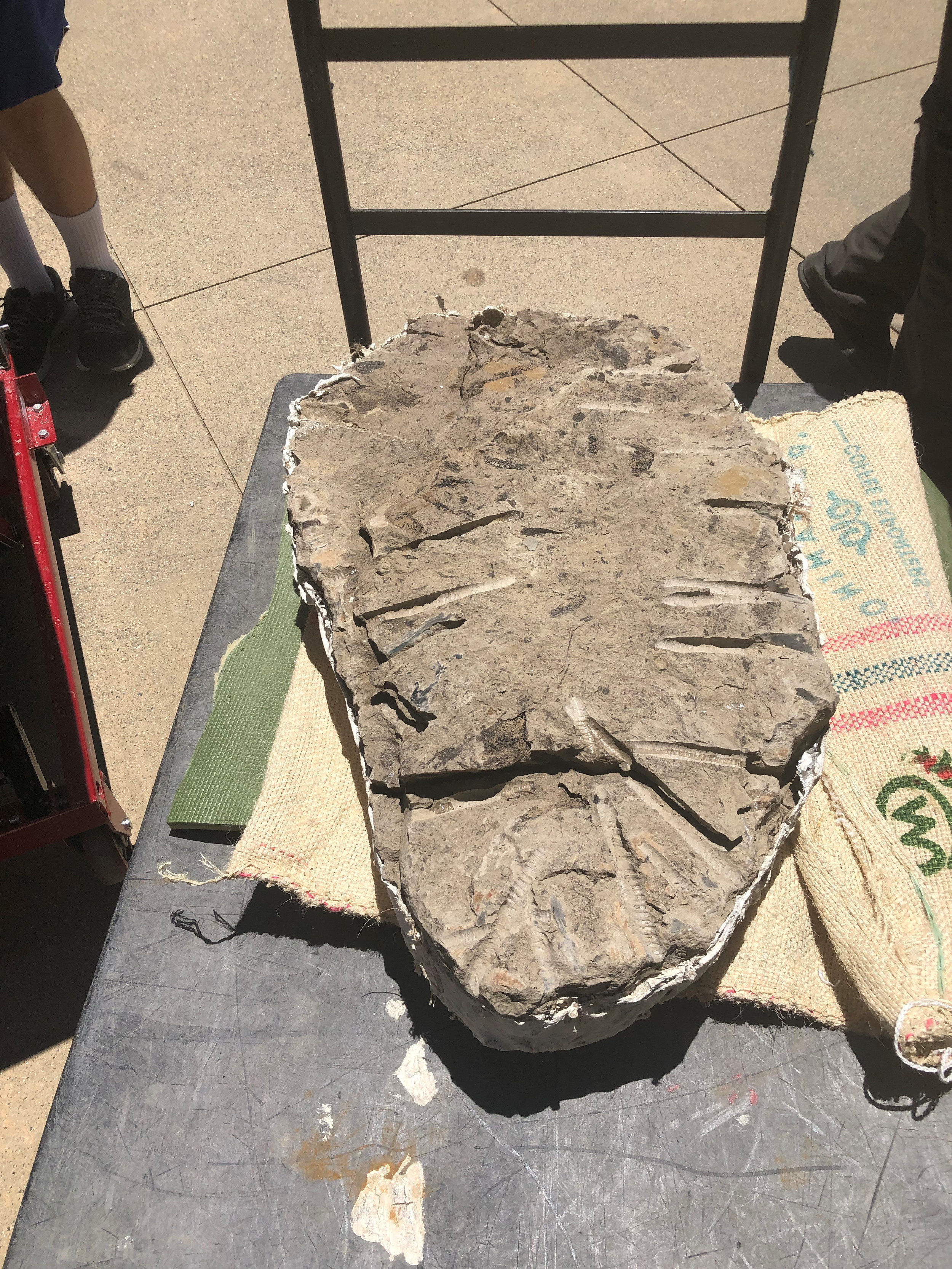 We'll sharing much more about these fossils in the coming weeks - stay tuned for more!Post by Brittney Stoneburg.
We'll sharing much more about these fossils in the coming weeks - stay tuned for more!Post by Brittney Stoneburg.